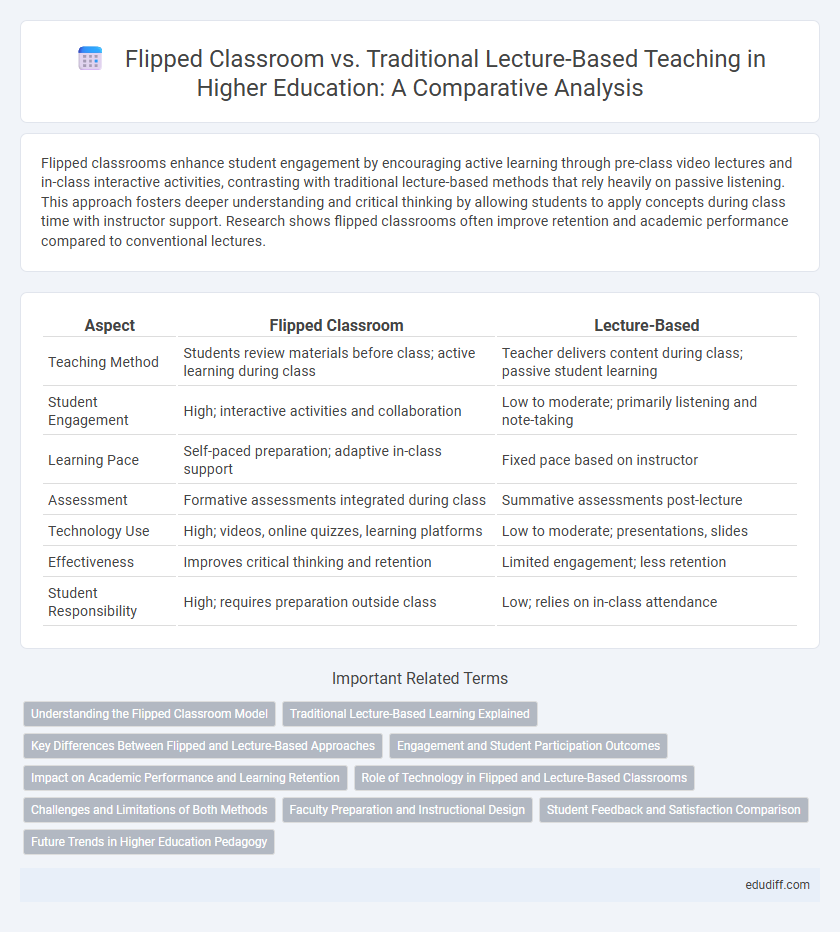Flipped classrooms enhance student engagement by encouraging active learning through pre-class video lectures and in-class interactive activities, contrasting with traditional lecture-based methods that rely heavily on passive listening. This approach fosters deeper understanding and critical thinking by allowing students to apply concepts during class time with instructor support. Research shows flipped classrooms often improve retention and academic performance compared to conventional lectures.
Table of Comparison
| Aspect | Flipped Classroom | Lecture-Based |
|---|---|---|
| Teaching Method | Students review materials before class; active learning during class | Teacher delivers content during class; passive student learning |
| Student Engagement | High; interactive activities and collaboration | Low to moderate; primarily listening and note-taking |
| Learning Pace | Self-paced preparation; adaptive in-class support | Fixed pace based on instructor |
| Assessment | Formative assessments integrated during class | Summative assessments post-lecture |
| Technology Use | High; videos, online quizzes, learning platforms | Low to moderate; presentations, slides |
| Effectiveness | Improves critical thinking and retention | Limited engagement; less retention |
| Student Responsibility | High; requires preparation outside class | Low; relies on in-class attendance |
Understanding the Flipped Classroom Model
The flipped classroom model redefines traditional education by shifting direct instruction outside of class, allowing in-person sessions to focus on interactive, application-based learning. Studies indicate that this approach enhances student engagement and improves comprehension by promoting active participation and immediate feedback. Compared to lecture-based methods, the flipped classroom supports deeper understanding through collaborative activities and personalized instructor support.
Traditional Lecture-Based Learning Explained
Traditional lecture-based learning involves an instructor delivering content directly to students in a structured classroom setting. This method emphasizes passive information absorption, where students listen, take notes, and memorize key concepts. Despite its long-standing use, lecture-based learning often limits student engagement and critical thinking opportunities compared to more interactive models like the flipped classroom.
Key Differences Between Flipped and Lecture-Based Approaches
The flipped classroom reverses traditional teaching by delivering instructional content outside of class, freeing in-class time for interactive activities and personalized support, whereas lecture-based approaches primarily rely on direct instruction during class periods with passive student listening. In flipped models, students engage with material through videos or readings at their own pace, promoting active learning and deeper comprehension, while lecture-based formats often limit student interaction and immediate feedback. Research indicates that flipped classrooms enhance critical thinking skills and retention rates compared to lecture-based methods, benefiting learner engagement and academic performance.
Engagement and Student Participation Outcomes
Flipped classroom models significantly increase student engagement and participation by transforming passive lecture time into active, collaborative learning sessions. Research indicates that students in flipped classrooms demonstrate higher levels of interaction, critical thinking, and motivation compared to traditional lecture-based formats. Enhanced engagement in flipped settings correlates with improved academic performance and deeper comprehension of complex concepts.
Impact on Academic Performance and Learning Retention
Flipped Classroom models significantly enhance academic performance and learning retention by promoting active engagement and personalized pacing, which contrasts with the passive reception typical of Lecture-Based approaches. Studies reveal that students in flipped settings demonstrate higher test scores and deeper understanding, attributed to pre-class content review and in-class problem-solving activities. This approach fosters long-term retention by encouraging critical thinking and immediate application of knowledge, exceeding the short-term memorization often seen in traditional lectures.
Role of Technology in Flipped and Lecture-Based Classrooms
Technology in flipped classrooms enables personalized learning through video lectures and interactive platforms, fostering student engagement and self-paced study. Lecture-based classrooms often utilize technology for content delivery such as PowerPoint presentations and live streaming but tend to offer less interactivity. The integration of adaptive learning software and real-time feedback tools significantly enhances the flipped model's effectiveness compared to traditional lectures.
Challenges and Limitations of Both Methods
Flipped Classroom faces challenges such as students' varying access to technology and the need for strong self-motivation, which can hinder participation and learning outcomes. Lecture-Based methods often struggle with passive learning, limited student engagement, and difficulty addressing diverse learning paces, impacting knowledge retention. Both approaches require careful implementation to overcome limitations related to student adaptability and instructional design, influencing overall educational effectiveness.
Faculty Preparation and Instructional Design
Effective faculty preparation in flipped classrooms requires comprehensive training in content digitization, student engagement strategies, and technological tools, contrasting with the more traditional lecture-based methods that often emphasize content delivery skills. Instructional design in flipped classrooms prioritizes active learning elements such as pre-class materials, interactive activities, and formative assessments, fostering deeper cognitive engagement compared to the passive reception model characteristic of lecture-based formats. Empirical studies show that faculty investment in developing well-structured flipped classroom modules enhances student outcomes and satisfaction more significantly than conventional lecturing preparation.
Student Feedback and Satisfaction Comparison
Student feedback in Flipped Classroom settings consistently highlights increased engagement, deeper understanding, and greater satisfaction compared to traditional Lecture-Based methods. Surveys indicate a 25% higher enjoyment rate and improved self-reported learning outcomes in Flipped Classrooms. Lecture-Based instruction often receives criticism for passive learning experiences and lower interaction levels, reflecting in reduced student satisfaction scores.
Future Trends in Higher Education Pedagogy
Flipped Classroom models emphasize active, student-centered learning by leveraging digital content outside the classroom, fostering critical thinking and collaboration skills essential for future workplaces. Lecture-Based approaches, while efficient for content delivery, face challenges adapting to diverse learning styles and integrating emerging technologies like AI and adaptive learning systems. Future trends in higher education pedagogy prioritize hybrid models combining flipped methodologies with AI-driven personalization to optimize engagement, retention, and real-world application of knowledge.
Flipped Classroom vs Lecture-Based Infographic

 edudiff.com
edudiff.com